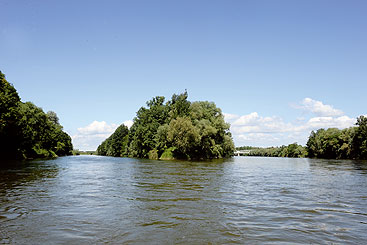
Cooperation for common solutions
The joint management of the Sava River Basin by Bosnia and Herzegovina, Croatia, Serbia and Slovenia is an important prerequisite for sustainable development by the participating countries, bringing important potential benefits for the Danube Basin as well.

The junction of the Krka and Sava Rivers in Slovenia. The large retention areas of the Sava are one of the most effective flood control systems in Europe. Their management is seen as an international model for sustainable flood management.
This 2 June marked four years since the creation of the International Sava River Basin Commission (ISRBC) to implement the Framework Agreement on the Sava River Basin (FASRB). Over the last four years the ISRBC has made considerable progress in inplementing the FASRB, providing the first remarkable results towards the achievement of its principal goals – the establishment of the international regime of navigation on the Sava River and its navigable tributaries, and the establishment of sustainable water management in the Sava River Basin.
The Sava River Basin Management Plan and the Flood Risk Management Plan are being developed in accordance with the EU Water Framework Directive and Flood Directive. A European Commission-funded project, to be launched by the end of this year, will follow up the recently finalised Characterisation Report and will significantly support further development of the Sava RBM Plan by 2011. Initial steps in the establishment of the Sava GIS have been made as well.
Much progress has been made in the field of navigation. The ISRBC has developed a set of rules to develop a unified regulatory system in the Sava River Basin, harmonised with the rules at European level, and work to re-establish the marking system on the Sava River waterway is nearly finished. A feasibility study for the rehabilitation and development of transport and navigation on the Sava River waterway is complete, and will be followed up with environmental impact assessment studies and a detailed design of the waterway. Additionally, the establishment of the River Information Services on the Sava River is under way.
Meeting everyone’s needs. By the nature of the FASRB, the ISRBC is supposed to balance the needs for development against environmental protection requirements. In this regard, the implementation of the Joint Statement on Guiding Principles for the Development of Inland Navigation and Environmental Protection in the Danube River Basin is considered highly important and beneficial.

The Second Meeting of the Parties to the Framework Agreement on the Sava River Basin was held on Sava Day, 1 June 2009.
“Implementation is very important in the Sava River Basin, considering that the Sava River waterway has been neglected for many years,” says Branko Bačić, ISRBC Chairman. “We still have many important steps to take where we can demonstrate the implementation of the Joint Statement, and I believe that our joint efforts will finally result in a project that will be supported by all relevant stakeholders.”
Implementation of the Joint Statement is, furthermore, a core of a good cooperation of the ISRBC with the ICPDR and the Danube Commission, in addition to the Memorandums of Understanding on cooperation that have been signed with the two Danube commissions.
Cooperation continues. Sustainable development of the region was also a focus of the Second Meeting of the Parties to the FASRB, held on Sava Day, 1 June 2009, in Belgrade. The Declaration was adopted at the meeting, and the Parties signed the protocol preventing water pollution caused by navigation. The meeting encouraged final harmonisation of two additional protocols, regulating the issues of flood protection and emergency situations.
“This is considerably important for all countries, and especially, for the Republic of Serbia, since protection against detrimental effects of waters, such as floods, as well as water quality protection, is highly significant for downstream countries in the basin and given the water supply of the settlements along the Sava River – such as Sremska Mitrovica, Šabac, Belgrade, etc.,” says Ambassador Stanimir Vukićević, of the Ministry of Foreign Affairs of the Republic of Serbia.
With a good spirit and strong willingness to succeed, the commitment of the Parties remains focused on future progress. “The Sava River is the communion of our interests in the region in terms of economic, political, social and cultural context,” says Djurdja Adlešić, Vice-president of the Government of the Republic of Croatia.
For more information, please visit: www.savacommission.org
Disclaimer
The information contained in the ICPDR website is intended to enhance public access to information about the ICPDR and the Danube River. The information is correct to the best of the knowledge of the ICPDR Secretariat. If errors are brought to our attention we will try to correct them.
The ICPDR, expert group members, nor other parties involved in preparation of information contained on this website cannot, however, be held responsible for the correctness and validity of the data and information provided, nor accept responsibility or liability for damages or losses arising directly or indirectly from the use of the information conveyed therein.
Only those documents clearly marked ICPDR documents reflect the position of the ICPDR.
Any links to other websites are provided for your convenience only. The ICPDR does not accept any responsibility for the accuracy, availability, or appropriateness to the user's purposes, of any information or services on any other website.
When using the information and material provided on this website, credit should be given to the ICPDR.
